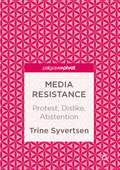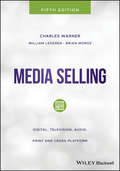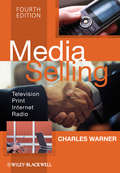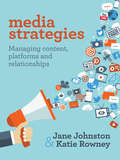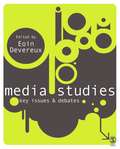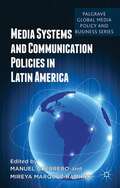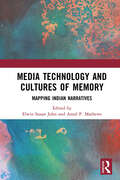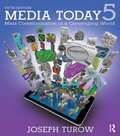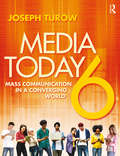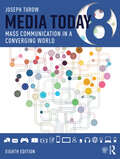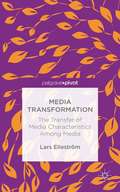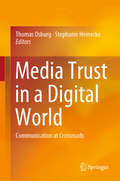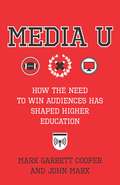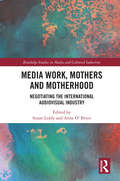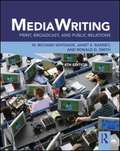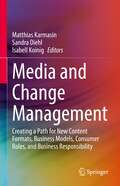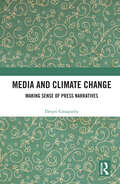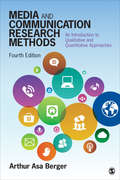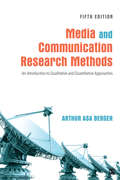- Table View
- List View
Media Resistance
by Trine SyvertsenThis book is open access under a CC BY license. New media divide opinion; many are fascinated while others are disgusted. This book is about those who dislike, protest, and try to abstain from media, both new and old. It explains why media resistance persists and answers two questions: What is at stake for resisters and how does media resistance inspire organized action? Despite the interest in media scepticism and dislike, there seems to be no book on the market discussing media resistance as a phenomenon in its own right. This book explores resistance across media, historical periods and national borders, from early mass media to current digital media. Drawing on cases and examples from the US, Britain, Scandinavia and other countries, media resistance is discussed as a diverse phenomenon encompassing political, professional, networked and individual arguments and actions. di
Media Selling: Digital, Television, Audio, Print and Cross-Platform (Wiley Desktop Editions Ser.)
by Charles Warner William Lederer Brian MorozThe must-have resource for media selling in today’s technology-driven environment The revised and updated fifth edition of Media Selling is an essential guide to our technology-driven, programmatic, micro-targeted, mobile, multi-channel media ecosystem. Today, digital advertising has surpassed television as the number-one ad investment platform, and Google and Facebook dominate the digital advertising marketplace. The authors highlight the new sales processes and approaches that will give media salespeople a leg up on the competition in our post-Internet media era. The book explores the automated programmatic buying and selling of digital ad inventory that is disrupting both media buyers and media salespeople. In addition to information on disruptive technologies in media sales, the book explores sales ethics, communication theory and listening, emotional intelligence, creating value, the principles of persuasion, sales stage management guides, and sample in-person, phone, and email sales scripts. Media Selling offers media sellers a customer-first and problem-solving sales approach. The updated fifth edition: Contains insight from digital experts into how 82.5% of digital ad inventory is bought and sold programmatically Reveals how to conduct research on Google Analytics Identifies how media salespeople can offer cross-platform and multi-channel solutions to prospects’ advertising and marketing challenge Includes insights into selling and distribution of podcasts Includes links to downloadable case studies, presentations, and planners on the Media Selling website Includes an extensive Glossary of Digital Advertising terms Written for students in communications, radio-TV, and mass communication, Media Selling is the classic work in the field. The updated edition provides an indispensable tool for learning, training, and mastering sales techniques for digital media.
Media Selling: Television, Print, Internet, Radio
by Charles WarnerThis newly revised and updated edition of Media Selling addresses the significant changes that have taken place in media industries over the last few years, while continuing as a seminal resource for information on media sales. A classic in this field, this book has long served students and professionals in broadcasting and media industries as an indispensable tool for learning, training, and mastering sales techniques for electronic media Addresses the unprecedented consolidation and sweeping change faced by media industries in recent years, and now features greatly expanded coverage of the Internet, including video streaming and the impact of social network sites Covers a broad span of media industries and issues, including: electronic media, newspapers, magazines, outdoor/billboard promotion, sales ethics, emotional intelligence, and interactive media selling Fully updated to include much greater focus on national and international media sales issues, as well as expanded coverage of network-level selling, product placement, sales promotion use of market data
Media Sex: What Are the Issues? (Routledge Communication Series)
by Barrie GunterThis book examines the representation, impact, and issues relating to the control and regulation of sex in the media. It covers work that has been conducted around the world on the depiction of sex in the mainstream mass media, especially the audio-visual media of film, television, and video, and the alleged effects that such content may have upon media consumers. In addition to reviewing the research on the effects of media sex, the book also examines what is known about public opinion concerning sex in the media. A key theme running through the book is whether the evidence about media sex can be taken at face value. Are the methodologies used by researchers to investigate media sex problematic? Have they yielded data that can be questioned in terms of validity and reliability? Media Sex questions whether media sex poses a serious problem for most viewers of mainstream media. It acknowledges that there may be serious issues relating to the causation of public offense and the cultivation of anti-women attitudes and beliefs that need to be addressed in productions where more extreme forms of sexual conduct are combined with violent and sadistic behavior. With the unrelenting growth of media, media consumers demand and are given greater personal control over the reception of media content. The notion of freedom of speech conflicts with the view that media content needs to be centrally regulated and controlled. This conflict creates problems for regulatory organizations and the legislators in nation states in which freedom of the press is legally protected. The book examines the debate surrounding this conflict.
Media Strategies: Managing content, platforms and relationships
by Jane Johnston Katie RowneyMedia Strategies maps the complex and disruptive media environment for the communication professional and provides the tools and methods to work effectively within it. Increasingly, communication professionals need to be accomplished content managers, capable of employing an arsenal of multi-media tactics across different platforms. This book presents new and innovative approaches to media relations, brand journalism and content management, providing practitioners with the tools to creatively develop, share and deliver strategic media assets and ideas that cut through the cluttered digital environment. The authors also demonstrate that personal and traditional skills are as important as ever, including the ability to tell stories, create memorable media pitches, write and lay-out media materials, and develop credibility and trust in relationships. Media Strategies sets a new agenda for anyone seeking to build a career as a professional communicator. It includes examples from around the world, from corporate, political, government, not-for-profit and activist communication and public relations practice.'The game has changed. Communications professionals should look to this as their guide when navigating a swiftly changing media landscape.' Ross Healy, Brand Social Media Specialist 'Media Strategies cuts through the hype to show how you can build your skills and excel as a communicator in both traditional media and the disruptive digital media platforms.' Elissa Trezia, Financial Technology PR Executive, Indonesia 'An excellent guide to the complex media landscape.' Catherine Archer, Academic Chair, Strategic Communication, Murdoch University
Media Studies: Key Issues and Debates
by Eoin DevereuxBringing together a range of renowned scholars in the field, this book examines eighteen key issues within contemporary media studies. Written in an accessible student-friendly style, Media Studies - Key Issues and Debates is an authoritative landmark text for undergraduate students. Each individual chapter begins with a concise definition of the concept(s) under investigation. This is followed by a 5,000 word discussion on the current state of play within research on the specific area. Chapters contain case-studies and illustrative materials from Europe, North America, Australasia and beyond. Each chapter concludes with annotated notes, which guide the student-reader in terms of future study. With a preface by Denis McQuail, contributors include Janet McCabe, John Corner, David Croteau, William Hoynes, Natalie Fenton, Jenny Kitzinger, Jeroen de Kloet, Liesbet van Zoonen, Sonia Livingstone and Greg Philo.
Media Systems And Communication Policies In Latin America
by Manuel Alejandro Guerrero Mireya Márquez-RamírezMedia Systems and Communication Policies in Latin America proposes, tests and analyses the liberal captured model. It explores to what extent to which globalisation, marketization, commercialism, regional bodies and the nation State redefine the media's role in Latin American societies.
Media Tactics in the Long Twentieth Century (Routledge Studies in Media, Communication, and Politics)
by Marie Cronqvist Emil Stjernholm Fredrik Mohammadi NorénIntegrating media studies with history, Media Tactics in the Long Twentieth Century explores the dynamic relationship between tactics and strategies in recent history.Drawing on examples from a range of different countries and world regions, and looking at the infrastructures, entanglements, and institutions involved, the volume makes a strong case for media tactics as a new field of scholarly inquiry and for the importance of a historically informed approach. In contrast to strategic communication approaches, this media historical intervention contributes to new knowledge about the practical implementation of strategies. First foregrounding tactics as an object of study, the volume then counters the presentism of contemporary studies by adding a necessary historical perspective. Moreover, the book theoretically disentangles the concept of strategy – from an abstract contemporary buzzword to concrete, hands-on actions – which in turn reveals the complexity of using media strategies and media tactics in reality.This volume will interest scholars and students working in the field of media and communication in general, and in the subfields of strategic communication, public relations, media history, and propaganda studies.The Open Access version of this book, available at http://www.taylorfrancis.com, has been made available under a Creative Commons [Attribution-Non Commercial-No Derivatives (CC-BY-NC-ND)] 4.0 license.
Media Technology and Cultures of Memory: Mapping Indian Narratives
by Elwin Susan John Amal P. MathewsMedia Technology and Cultures of Memory studies narrative memories in India through oral, chirographic and digital cultures. It examines oral cultures of memory culled from diverse geographical and cultural landscapes of India and throws light on multiple aspects of remembering and registering the varied cultural tapestry of the country. The book also explores themes such as oral culture and memory markers; memory and its paratextual services; embodied memory practices in the cultural traditions; between myths and monuments; literary and lived experiences; print culture and memory markers; marginalized memories in hagiographies; displaying memories online; childhood trauma, memory and flashbacks; and the politics of remembering and forgetting. Rich in case studies from across India, this interdisciplinary book is a must-read for scholars and researchers of cultural studies, sociology, political science, English literature, South Asian studies, social anthropology, social history, and post-colonial studies.
Media Today
by Joseph Turow"Turow's Media Today: Mass Communication in a Converging World, now in its fifth edition, chooses [a] cutting-edge option. This is a student-friendly publication, offering aids such as definitions of key terms, colourful infographics, case studies and end-of-chapter review questions. There's a companion website, too, and a password-protected website for instructors."--Philip Kemp, Times Higher Education Media Today uses convergence as a lens that puts students at the center of the profound changes in the 21st century media world. Through the convergence lens they learn to think critically about the role of media today and what these changes mean for their lives presently and in the future. The book's media systems approach helps students to look carefully at how media is created, distributed, and exhibited in the new world that the digital revolution has created. In this way, Media Today goes beyond the traditional mass communication textbook's focus on consuming media, to give students an insider's perspective on how media businesses operate. How exactly does Google profit from web searches? What will a magazine look like five years from now? Informative and engaging, Media Today, Fifth Edition, is characterized by its focus on: Convergence: In addition to separate chapters on the Internet and the Video Games industry, coverage of convergence and its impact is incorporated into every chapter. Consumer Education: Media Literacy questions ask students to consider their roles as a media consumer and potential media creator. Comprehensive Media Industry Coverage: Historical timelines in the print book and on the companion website track the development of each media industry, giving students an overview of a particular industry at a glance. Contemporary, Student-friendly Examples: New culture and media boxes help students think about the impact of media industries on their own lives and globally. Joseph Turow--who has been teaching Intro to Mass Communication for well over a decade--demonstrates the many ways that media convergence and the pervasiveness of the Internet have blurred distinctions between and among various media. From newspapers to video games or social networking to mobile platforms, Media Today prepares students to live in the digital world of media.
Media Today: Mass Communication in a Converging World
by Joseph TurowMedia Today uses convergence as a lens that puts students at the center of the profound changes in the 21st century media world. Through the convergence lens they learn to think critically about the role of media today and what these changes mean for their lives presently and in the future. The book’s media systems approach helps students to look carefully at how media content is created, distributed, and exhibited in the new world that the digital revolution has created. From newspapers to video games and social networking to mobile platforms, Media Today prepares students to live in the digital world of media.
Media Today: Mass Communication in a Converging World
by Joseph TurowThis eighth edition of Joseph Turow’s pathbreaking media textbook uses convergence as a lens that puts students at the center of the profound changes in the 21st century media world. It teaches students to think critically about the role of media, and what these changes mean for their lives. The book’s media systems approach helps students to look carefully at how media content is created, distributed, and exhibited in the new world that the digital revolution has created. From news media to video games and social networking to mobile platforms, it provides students with the tools they need to understand and critique the media they encounter and consume. The first part examines the media world as a whole, while the second delves deep into key media industries, such as the movie, television, and video game industries. This new edition includes critical expanded coverage of social media, new forms of both audio and audiovisual media and international case studies, as well as updated figures, tables, and pedagogy, including key terms and further activities. Media Today is an excellent introduction to the world of media in the digital age, perfect for students seeking a solid grounding in media studies. Extensive pedagogical materials also make this a highly teachable book, well suited to the classroom. The accompanying website has also been updated with new student and instructor resources, including chapter recaps, recommended readings, and instructor’s manual.
Media Training in Transition Countries: Perspectives of a Media Trainer
by Sam SwanThis book explores the impact of, and lessons learned from, media development and training programs sponsored by the US government and non-governmental organizations in countries transitioning to democracy. Recognizing the importance of establishing a free press and a free market economy in newly democratic societies, this book examines the training of journalists and media managers in selected countries in Eastern Europe, Africa, Asia, the Middle East, and South America. Drawing on the author’s and other media trainers’ experiences over a 25-year period, this book provides important insights into tailoring training programs to specific regions and countries. Case studies describe training in radio and television management, broadcasting, and media sustainability, and are contextualized against the cultural and historical backgrounds of each region. Media Training in Transition Countries will be of interest to media trainers, government and nongovernment agencies, and scholars and students of international journalism and development.
Media Transatlantic: Developments in Media and Communication Studies between North American and German-speaking Europe
by Norm FriesenThis book reflects recent scholarly and theoretical developments in media studies, or Medienwissenschaft. It focuses on linkages between North America and Germanâe speaking Europe, and brings together and contextualizes contributions from a range of leading scholars. In addition to introducing Englishâe language readers to some of the most prominent contemporary German media theorists and philosophers, including Claus Pias, Sybille Krämer and Rainer Leschke, the book shows how foundational North American contributions are themselves inspired and informed by continental sources. This book takes Harold Innis or Marshall McLuhan (and other members of the "Toronto School") as central points of reference, and traces prospective and retrospective lines of influence in a cultural geography that is increasingly global in its scope. In so doing, the book also represents a new episode in the international reception and reinterpretation of the work of Innis and McLuhan, the two founders of the theory and study of media.
Media Transformation: The Transfer of Media Characteristics Among Media (Palgrave Pivot)
by Lars ElleströmThis is a methodical study of the material, mental limit and possibilities of transferring information and media characteristics among dissimilar media. Ellestrom proposes a model for pinpointing the most vital conceptual entities and stages in intermedial transfers with different media that have common traits that enable systematic comparison.
Media Trust in a Digital World: Communication at Crossroads
by Thomas Osburg Stephanie HeineckeThis book examines the shifting role of media trust in a digital world, and critically analyzes how news and stories are created, distributed and consumed. Emphasis is placed on the current challenges and possible solutions to regain trust and restore credibility. The book reveals the role of trust in communication, in society and in media, and subsequently addresses media at the crossroads, as evinced by phenomena like gatekeepers, echo chambers and fake news. The following chapters explore truth and trust in journalism, the role of algorithms and robots in media, and the relation between social media and individual trust. The book then presents case studies highlighting how media creates trust in the contexts of: brands and businesses, politics and non-governmental organizations, science and education. In closing, it discusses the road ahead, with a focus on users, writers, platforms and communication in general, and on media competency, skills and education in particular.
Media U: How the Need to Win Audiences Has Shaped Higher Education
by John Marx Mark Garrett CooperAre homecoming games and freshman composition, Twitter feeds and scholarly monographs really mortal enemies? Media U presents a provocative rethinking of the development of American higher education centered on the insight that universities are media institutions. Tracing over a century of media history and the academy, Mark Garrett Cooper and John Marx argue that the fundamental goal of the American research university has been to cultivate audiences and convince them of its value.Media U shows how universities have appropriated new media technologies to convey their message about higher education, the aims of research, and campus life. The need to create an audience stamps each of the university’s steadily proliferating disciplines, shapes its structure, and determines its division of labor. Cooper and Marx examine how the research university has sought to inform publics and convince them of its value to American society, from the rise of football and Great Books programs in the early twentieth century through a midcentury communications complex linking big science, New Criticism, and design, from the co-option of 1960s student activist media through the early-twenty-first-century reception of MOOCs and the latest promises of technological disruption. The book considers the ways in which universities have used media platforms to reconcile national commitments to equal opportunity with corporate capitalism as well as the vexed relationship of democracy and hierarchy. By exploring how media engagement brought the American university into being and continues to shape academic labor, Media U presents essential questions and resources for reimagining the university and confronting its future.
Media Work, Mothers and Motherhood: Negotiating the International Audio-Visual Industry (Routledge Studies in Media and Cultural Industries)
by Anne O'Brien Susan LiddyThis interdisciplinary and international volume offers an innovative and critical exploration of the impact of motherhood on the engagement of women in media and creative industries across the globe. Diverse contributions critically engage with the intersections and overlap between the social categories of worker and mother, and the work of media production and maternal caregiving. Conflicting ideas about, and expectations of, mothers are untangled in the context of the working world of radio, film, television and creative media industries. The book teases out commonalities between experiences that are evident across a number of countries, from Hollywood to Bollywood, as well as examining the differences between class, religion, maternal status and cultural frameworks that surround working mothers in various nation states. It also offers some possibilities for ways forward that can improve the lives of women workers who are also mothers. A timely and valuable contribution to international debates on equality, mothers and motherhood in audiovisual industries, this book will be of interest to scholars and students of media, communication, cultural studies and gender, programmes engaged with work inequalities and motherhood studies, and activists, funders, policymakers and practitioners.
Media Writers Handbook
by George T. ArnoldDiscusses common pitfalls in journalistic writing and how to avoid them.
Media Writing: Print, Broadcast, and Public Relations
by Ronald D. Smith Janet E. Ramsey W. Richard WhitakerComplete with real-world examples, practical writing exercises, and tips and information for entering into the profession, MediaWriting continues to give students the tools they need to become a successful media writer. The new edition has been extensively rewritten to reflect the dynamic nature of the profession, paying significant attention to how the Internet and social media have become essential communication tools for print and broadcast journalists, and public relations professionals.
Media and Change Management: Creating a Path for New Content Formats, Business Models, Consumer Roles, and Business Responsibility
by Sandra Diehl Matthias Karmasin Isabell KoinigChange management is not just affected globally by environmental and social conditions, including political and technological changes, but also through convergence, which helps conceptualize change over the past decades. The media industry, in particular, is being challenged by the rise of social media, the crisis of refinancing especially for quality news media, the ‘misinformation epidemic’, and the changing role of legacy media. The evolving nature of media usage and communication, the rise of produsage and influencers, and intermediaries and their personalized algorithmic content are also factors that impact the industry, along with data privacy and privacy management, and the “new responsibilities” of companies such as sustainability, agility and resilience, etc.This book focuses on permanent change management in the media and related industries. It provides insights into the most common and crucial phenomena of media and change management in general, while also revealing some more specific issues brought about by technical and social innovations. The authors expand the meaning of media management beyond the management functions within the industry to include the management of different media. The book serves as a useful guide for researchers, students, and practitioners alike, as they are all affected by change processes.
Media and Climate Change: Making Sense of Press Narratives
by Deepti GanapathyThis book looks at the media’s coverage of climate change and investigates its role in representing the complex realities of climate uncertainties and its effects on communities and the environment. The book explores the socio-economic and cultural understanding of climate issues, the influence of environment communication via the news and the public response to it. It also examines the position of the media as facilitator between scientists, policy makers and the public. Drawing extensively from case studies, personal interviews, comparative analysis of international climate coverage, and a close reading of newspaper reports and archives, the author studies the pattern and frequency of climate coverage in the Indian media and their outcomes. With a special focus on the Western Ghats, the book also discusses political rhetoric, policy parameters and events which trigger a debate about development over biodiversity crisis and environmental risks in India. This book will be of great interest to scholars and researchers of environmental studies, especially climate change, media studies, public policy and South Asian studies as well as a conscientious citizen who deeply cares for the environment.
Media and Communication Research Methods: An Introduction to Qualitative and Quantitative Approaches
by Dr Berger Arthur AMedia and Communication Research Methods, Fourth Edition is a concise and practical text designed to give students a step-by-step introduction to conducting media and communication research. Offering real-world insights along with the author’s signature animated style, this text makes the discussion of complex qualitative and quantitative methods easy to comprehend. Packed with detailed examples and practical exercises, the Fourth Edition of this bestselling introductory text includes a new chapter on discourse analysis; expanded discussion of social media, expanded coverage of the research process, and more. Ideal for undergraduate and graduate students conducting research for the first time, this accessible text will help students understand, practice, and master media and communication research.
Media and Communication Research Methods: An Introduction to Qualitative and Quantitative Approaches
by Dr Berger Arthur AMedia and Communication Research Methods, Fourth Edition is a concise and practical text designed to give students a step-by-step introduction to conducting media and communication research. Offering real-world insights along with the author’s signature animated style, this text makes the discussion of complex qualitative and quantitative methods easy to comprehend. Packed with detailed examples and practical exercises, the Fourth Edition of this bestselling introductory text includes a new chapter on discourse analysis; expanded discussion of social media, expanded coverage of the research process, and more. Ideal for undergraduate and graduate students conducting research for the first time, this accessible text will help students understand, practice, and master media and communication research.
Media and Communication Research Methods: An Introduction to Qualitative and Quantitative Approaches
by Dr Berger Arthur AThis step-by-step introduction to conducting media and communication research offers practical insights along with Arthur Asa Berger’s signature lighthearted style to make discussion of qualitative and quantitative methods easy to comprehend. The Fifth Edition of Media and Communication Research Methods includes a new chapter on discourse analysis; expanded discussion of social media, including discussion of the ethics of Facebook experiments; and expanded coverage of the research process with new discussion of search strategies and best practices for analyzing research articles. Ideal for research students at both the graduate and undergraduate level, this proven book is clear, concise, and accompanied by just the right number of detailed examples, useful applications, and valuable exercises to help students to understand, and master, media and communication research.
